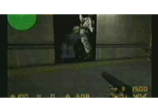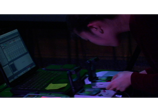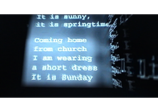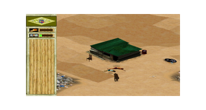8 BIT a documentary about art and video games
2006

This was the official website for the 2006 hybrid documentary, 8 BIT.
Content is from the site's 2006 archived pages.
8 BIT
a documentary about art and video games
mutationengine presents
8 BIT
a documentary
about art and video games
created by
Marcin RAMOCKI and Justin STRAWHAND
8 Bit Documentary Trailer
PRESS RELEASES
THE MUSEUM OF MODERN ART PRESENTS THE WORLD PREMIERE OF 8 BIT, A DOCUMENTARY ABOUT ART AND VIDEO GAME
S Film Examines Crossover of Ideas from Gaming Culture to the Fields of Music and Art
8 BIT
October 7, 8:00 p.m. October 11, 8:30 p.m. The Roy and Niuta Titus Theaters New York, September 12, 2006—The Museum of Modern Art presents the world premiere of 8 BIT (2006), a feature-length documentary exploring the history of artists and video games. This mélange of rockumentary and art exposé examines early hacker culture and interviews contemporary musicians, artists, and programmers who repurpose game hardware, modify existing games, and create original games.
Filmed in New York City, Los Angeles, Paris, and Tokyo, 8 BIT offers a global perspective on the artistic approaches of those who grew up playing early video games on the Atari and Commodore 64 consoles.
With commentary by media critic and author Ed Halter of The Village Voice, and new media curator and writer Christiane Paul of the Whitney Museum, as well as interviews with more than 20 artists and critics, these recent artistic strategies are put in the historical context of modernist and postmodernist discourse and examined as potential examples of a transition into fresh, uncharted territory.
8 BIT argues that in the 21st century, GameBoy rock, machinima, and game theory belong together and share a common root: the digital heritage of Generation X.
According to organizer Barbara London, “8 BIT ably chronicles the modernist and post-modernist tendencies in the relatively recent history of video game-based art, but also suggests that the bitbending antics of the post-video game generation hint at a new current in the uncharted waters of 21st century art history.”
8 BIT. (2006). USA. Original concept and direction by Marcin Ramocki. Produced and co-directed by Justin Strawhand. With artists Cory Arcangel, BIT SHIFTER, Bodenstandig 2000, Bubblyfish, Covox, Mary Flanagan, Alex Galloway, Gameboyzz Orchestra, Glomag, HUAROTRON, JODI, Paul Johnson, John Klima, Johan Kotlinski, Nullsleep, Joe McKay, Tom Moody, Akiko Sakaizumi, Eddo Stern, TEAMTENDO, Treewave, Chiaki Watanabe, and Carlo Zanni; curator Isabelle Arvers; media critic Ed Halter; and new media curator/writer Christiane Paul.
The premiere of 8 BIT is organized by Barbara London, Associate Curator, Department of Film and Media, The Museum of Modern Art.
The Museum of Modern Art 11 West 53rd Street, New York, NY 10019
Hours: Wednesday through Monday: 10:30 a.m.-5:30 p.m. Friday: 10:30 a.m.-8:00 p.m. Closed Tuesday
Film Admission: $10 adults; $8 seniors, 65 years and over with I.D. $6 full-time students with current I.D.
(For admittance to film programs only) Call (212) 708-9400 or go to www.moma.org for detailed museum information.
ABOUT

8 BIT is a hybrid documentary examining the influence of video games on contemporary culture.
A mélange of a rocumentary, art expose and a culture-critical investigation, 8 BIT ties together seemingly disconnected phenomena like the 80’s demo scene, chiptune music and contemporary artists using machinima and modified games.
Produced in NYC, LA, Paris and Tokyo, 8 BIT brings a global perspective on the new artistic approaches of the DIY generation which grew up playing Atari and Commodore 64.
Some of the artists featured in 8 BIT include Cory Arcangel, Bit Shifter, Bodenstandig 2000, Bubblyfish, Mary Flanagan, Alex Galloway, Glomag, Paul Johnson, John Klima, Johan Kotlinski, Nullsleep, Joe McKay, Tom Moody, Akiko Sakaizumi, Eddo Stern, TEAMTENDO, Treewave and Carlo Zanni.
With the help of media critic Ed Halter and new media curator and writer Christiane Paul, these very recent artistic strategies are put in the historical context of modernist and postmodernist discourse and examined as potential examples of a transition into fresh, uncharted territory.
8 BIT insists that in the 21st century Game-Boy rock, machinima and game theory belong together and share a common root: the digital heritage of Generation X.


Joe McCay Audio Pong Cory Arcangel


Operation Velvet Strike Bubblyfish

Mary Flanagan / Domestic
8 BIT: A Documentary about Art and Videogames
World Premiere of Video Game Rockumentary at the Museum of Modern Art October 7th.
Explores worldwide artist subculture obsessed with repurposing old video games and computers
Barbara London, Museum of Modern Art curator: “8 BIT chronicles… the relatively recent history of video game-based art, but also suggests that the bit-bending antics of the post-video game generation hint at a new current in the uncharted waters of 21st century art history.”
New York 9.18.2006: Musicians, armed only with Nintendo Gameboys, play to packed concert halls. Hardware hacking punks turn ancient Ataris into video synthesizers. Politically charged cyber-performers spray protest graffiti in online post 9-11 war games. Artists obsess over Pac Man and Super Mario Brothers like Warhol mused over Campbell’s Soup and Marilyn Monroe.
These are the signs of a new cultural phenomenon sweeping the world. This “8-bit culture” scavenges the age of the arcade and the Atari for inspiration and cheap materials. Part nostalgia, part rejection of advancing technology, “8-bit culture” finds its voice by exploring and exploiting old technologies and ancient computers less powerful than today’s pocket calculators.
Malcom McClaren, writing in Wired Magazine: “Chip music… represent(s) the most anarchic display of the antihero in pop culture… repurposing defunct devices to end-run a music industry in total decline constitutes a revolution. Chip music is the final repository of the marvelous, its makers the last possessors of the wand of Cinderella's fairy godmother.”
8 BIT: A Documentary about Art and Videogames explores this “repository of the marvelous” through all of its incarnations, both in the musical and visual arts. By weaving together arcane histories of digital subterfuge, candid interviews with cutting-edge artists and theorists, wild videogame concerts, and highlights from the best digital artwork being made today, 8 BIT: A Documentary about Art and Videogames exposes the cultural ramifications of video games and proposes that Generation X’s coming to grips with its digital heritage signals the beginning of a new social and artistic reality.
COMMENTS
Wired Magazine
July 06 2007 | Permalink
Check out 8 BIT in the July WIRED. We're on the top ten things to do.
Artforum
December 01 2006 |
8 BIT in Top Ten Films of 2006
Gay Gamer Review
October 16 2006 |
Here you go!
ABC World News Tonight
October 16 2006 |
Check it out!
www.vh1gamebreak.com
October 10 2006 |
Harold Goldberg says:
8-Bit: The Best Game Movie Ever Made
Game Set Watch
October 05 2006 |
Here's a review by Matt Hawkins at Game Set Watch.
Excerpt:
The entire film is very easy to follow, with concepts and ideas flowing and connecting to each other seamlessly. And you honestly can't say about most films and television specials that have come before it. The editing is excellent, as is the use of illustrations and footage from games to paint various pictures, and each of the interviews, despite one's personal opinions of what is said, help to drive the filmmaker's intent. And that is to catalogue and document this emerging art scene. In the end, despite its problems, the good definitely outweigh the bad. 8 BIT is the start of something, and a very good one at that.
The Reeler
October 3, 2006 / By Paddy Johnson
Art Fag City: Video Game Culture Thrives in New Documentary
A new column spotlights film and video from the New York art community

If you happened to have grown up during the peak period of video game popularity in the '80s and '90s, you probably have a connection to the iconography and sounds of these products even if you don't have an awareness of the variety of subcultures they have since inspired. The shared experience of these two decades may not be enough for the casual viewing audience to understand everything discussed in 8 BIT: A Documentary about Art and Videogames, which premieres Oct. 7 at MoMA, but then again, author Brian Greene urged novice readers of The Elegant Universe, his famous book on string theory, to skip some of the more difficult chapters, and that didn't seem to adversely affect its popularity.
Unlike The Elegant Universe however, this movie was not designed with the intent to make specialized knowledge palatable to the public; videogame subculture is a response to products of mass culture and is thus generally accessible by its very nature. 8 BIT's primary goal is to treat video games as a medium independent from television, video, film, music etc. and situate artist practice within a modern and postmodern discourse. This is quite a lot to bite off given that this not only the first major cinematic attempt to do so, but is also a document of a scene so young that there are almost no artists who have been working in the medium longer than seven years. Yet the scene has become so large that the film selectively features more than 10 artists' music as well as interviews with over 20 key players in the field, from the famous crossover musician and gallery and Net artist Cory Arcangel to Game Boy musicians like Bubblyfish (and those who use even older gear like Treewave and Bodenstandig) to artists like John Klima who use recent game aesthetics to make their art to new media critics Mary Flanagan, Ed Halter and Tom Moody.
Incredibly, while young, the movement boasts enough practicing artists that omissions -- most notably the absence of the collective PaperRad -- are quite glaring. None of the members in this group may be programmers, but that is precisely the reason for inclusion: Visual artists without programming skills who are inspired by 8-bit visuals are hardly an insignificant part of the genre. PaperRad in particular speaks to how video game culture -- when interwoven with advertising, toys, animation, comic books and other cultural phenomena -- are part of the cultural consciousness of their generation.
Like virtually every artist featured in the film, the collective is part of a generation that has never known a time without video games. Perhaps this explains why the scene is made up of individuals who are incredibly intense. You really only need to see one shot of a group of computer nerds heavily concentrating on their portable game systems to get this idea, but if this isn't enough, you can take your pick of scenes with Moody, Alex Galloway and Nullsleep, who each provide more than enough commentary to convince you. Cultural critic Halter provides the best insight into this kind of consuming interest, describing an old video game from the '80s that created a huge controversy for its violent and bloody 8-pixel representation of an injury. Of course, the idea of such outrage today is ludicrous, but as Halter wisely points out, the fact that the cultural imagination could find scandal in these images reveals a significant level of investment in the games.
Illuminating clips and observations like these make the movie. The filmmakers work with the awareness that it isn't enough to simply say that artists grew up playing videogames; rather, they must attempt to illustrate what this means to this group of people. As a common attribute, the blogger and artist Moody tells me, "The DIY (do it yourself), hacker, guerrilla mindset is a constant theme... [T]he topic is bigger than videogames. One thing I like about the film is it casts its net wider than just a small scene."
And despite the omission I mentioned earlier, Moody is right. As the first movie of its kind to document and situate the 8-bit scene within contemporary art discourse, 8 BIT should be recognized for its potential to become a seminal document of 21st century new media arts.

CAST
Cory Arcangel
Isabelle Arvers
Bit Shifter
Bodenstandig 2000
Bubblyfish
Mary Flanagan
Alex Galloway
Gameboyzz Orchestra
Glomag
Rachel Greene
Ed Halter
Paul Johnson
John Klima
Johan Kotlinski
Nullsleep
Joe McKay
Tom Moody
Christiane Paul
Akiko Sakaizumi
Eddo Stern
teamtendo
Treewave
Carlo Zanni
FEATURING ORIGINAL MUSIC AND PERFORMANCES BY
Bit Shifter
Bodenstandig 2000
Bubblyfish
Covox
Gameboyzz Orchestra
Glomag
HUORATRON
Nullsleep
Role Model
teamtendo
Treewave
Chiaki Watanabe
AND THE WORK OF
Eboy
jodi
Velvet Strike
John Simon


John Simon Every Icon Eddo Stern Sheik Attack


Paul Johnson RGB Nullsleep

Carlo Zanni Average Shovellor

More Background On 8BitMovie.com
When 8BitMovie.com first went online in 2006, it was more than a promotional site — it was the digital nerve center for a cultural experiment. Created to accompany 8 BIT: A Documentary About Art and Video Games, the site chronicled a movement that merged art, technology, and nostalgia at a moment when gaming culture was beginning to be recognized as serious creative expression.
The film, directed by Marcin Ramocki and Justin Strawhand, was a pioneering exploration of how video games had shaped contemporary art and music. Long before the rise of mainstream “retro” culture, 8 BIT was already documenting a global community of artists who repurposed outdated hardware, transformed game code into art, and turned their childhoods with Atari and Nintendo into sophisticated cultural commentary.
Origins of the Project
8 BIT emerged from New York’s experimental art scene in the early 2000s, a period of renewed interest in the aesthetics of the 1980s. Independent galleries, laptop musicians, and media theorists were exploring how the earliest home consoles had influenced not just entertainment but an entire generation’s way of seeing and creating.
Marcin Ramocki, a Polish-born artist known for his digital installations and conceptual works, was fascinated by the overlap between visual art and software culture. His collaborator, filmmaker Justin Strawhand, shared an interest in the cultural afterlife of technology — how obsolete machines could be reimagined as tools for artistic rebellion. Together, they envisioned a film that would blur the line between documentary and art exhibition, highlighting creators who hacked, bent, and reinterpreted early video-game systems for new artistic ends.
Filming took place in New York City, Los Angeles, Paris, and Tokyo, capturing an international community of musicians, programmers, and visual artists. The result was a film that felt both local and global — rooted in the DIY ethos of underground culture but alive to the worldwide impact of gaming.
Premiere at the Museum of Modern Art
The world premiere of 8 BIT was held at New York’s Museum of Modern Art (MoMA) on October 7 and 11, 2006. Organized by Barbara London, associate curator in MoMA’s Department of Film and Media, the event signaled a turning point: for the first time, a major museum was treating the aesthetic of video games as a legitimate branch of contemporary art.
MoMA’s program notes described the documentary as “a mélange of rockumentary and art exposé,” capturing the crossover of ideas from gaming into the fields of music and visual culture. The screenings sold out quickly and were attended by critics, curators, and members of New York’s new-media community. For many, it was the first film to frame the subculture of “game artists” within a broader art-historical conversation — linking pixel graphics and 8-bit sound to modernist and post-modernist experimentation.
The Website: 8BitMovie.com
The film’s official site, 8BitMovie.com, mirrored the aesthetic principles of the movie itself. It featured blocky graphics, minimal navigation, and screenshots evocative of early computer interfaces. Visitors could view trailers, artist profiles, and press coverage while exploring a design that deliberately echoed the low-resolution world the film celebrated.
The site’s content served multiple roles:
-
It provided press information for screenings and festival submissions.
-
It showcased the cast of artists and musicians, including figures such as Cory Arcangel, Bit Shifter, Mary Flanagan, Bubblyfish, Nullsleep, and John Klima.
-
It documented the film’s critical reception, including praise from Wired, Artforum, VH1 Game Break, and ABC World News Tonight.
For many early internet users, 8BitMovie.com was the first portal introducing them to the “chiptune” scene and to the idea that digital nostalgia could be a medium for fine art.
Themes and Structure of the Film
At its heart, 8 BIT explored how a generation raised on video games was redefining art in the digital age. The filmmakers approached this through three major themes:
1. Repurposing Technology
The documentary highlighted artists who modified or “bent” old gaming hardware — turning Atari consoles, Game Boys, and Commodore 64s into instruments and canvases. Performers like Bubblyfish and Bit Shifter composed live music using handheld consoles, while visual artists such as John Klima and Carlo Zanni used vintage graphics as raw material for installations and internet-based art.
2. Cultural Reflection and Rebellion
The film positioned the 8-bit movement as a form of cultural critique. In a world obsessed with faster, newer, and more realistic technology, these artists deliberately chose the obsolete. Their pixelated worlds became acts of rebellion against digital perfection — a way to reclaim imperfection, playfulness, and human touch.
3. Artistic Lineage
Through commentary from media critic Ed Halter and new-media scholar Christiane Paul, the film linked this movement to earlier artistic traditions — from modernism’s fascination with machinery to post-modern appropriation and remix. 8 BIT argued that “Game Boy rock, machinima, and game theory” all stem from the same digital heritage of Generation X.
Cast and Collaborators
The cast list of 8 BIT reads like a roll call of the early-2000s digital-art underground:
-
Cory Arcangel, known for transforming Nintendo cartridges into conceptual artworks.
-
Bubblyfish (Haeyoung Kim), a classically trained musician who composed live electronic sets using Game Boys.
-
Bit Shifter (Josh Davis), a pioneer of chiptune performance.
-
Mary Flanagan, media theorist and game designer exploring feminist approaches to game space.
-
John Klima, creator of interactive installations that merge virtual and physical space.
-
Eddo Stern, whose work “Sheik Attack” examined political conflict through game imagery.
-
Tom Moody, an artist and blogger analyzing the aesthetic and social implications of lo-fi digital art.
Complementing these artists were critics and curators including Ed Halter, Christiane Paul, and Isabelle Arvers, who contextualized the movement within art history and media studies. The film also featured performances by Gameboyzz Orchestra, Teamtendo, Glomag, Nullsleep, and Treewave — all key figures in early chip-music culture.
Critical Reception
Upon release, 8 BIT drew widespread praise from both mainstream and niche publications.
-
Wired Magazine listed it among its Top Ten Things to Do in 2007, calling it a vivid portrayal of a “revolutionary repurposing of defunct devices.”
-
Artforum included 8 BIT in its Top Ten Films of 2006.
-
VH1 Game Break critic Harold Goldberg hailed it as “the best game movie ever made.”
-
ABC World News Tonight and Game Set Watch ran positive features, noting the film’s seamless editing and insightful commentary.
Reviewers praised its ability to connect diverse disciplines — from pop music to philosophy — into a coherent picture of how digital art was evolving. The Reeler and Art Fag City emphasized the film’s contribution to legitimizing gaming as a cultural medium, likening its scope to The Elegant Universe for string theory readers — an ambitious, boundary-crossing introduction to a new field.
Cultural and Social Significance
The success of 8 BIT came at a key historical moment. The mid-2000s were the dawn of Web 2.0, social networking, and the democratization of creative tools. Artists could distribute their work online without institutional gatekeepers, and audiences were rediscovering the aesthetics of early computing through emulators, pixel art, and retro sound design.
Within that landscape, 8 BIT became an unofficial manifesto for digital DIY culture. It celebrated the same principles later embraced by maker communities, indie game developers, and electronic musicians. The film suggested that nostalgia, rather than being regressive, could be a platform for innovation — that creative recycling of technology might be the truest form of progress.
The documentary also reflected the growing academic interest in game studies. Universities were beginning to establish programs in interactive media and design, and 8 BIT provided a visual companion to the theories being written about play, authorship, and code as art.
Influence and Legacy
In retrospect, 8 BIT occupies a seminal place in the history of digital-culture documentaries. It predated later works like Indie Game: The Movie (2012) and The King of Kong (2007), and its emphasis on art rather than competition distinguished it from both mainstream gaming films and academic essays.
The artists it featured went on to significant careers:
-
Cory Arcangel exhibited at the Whitney Museum and Tate Modern.
-
Eddo Stern became a professor at UCLA’s Game Lab.
-
Mary Flanagan founded the Tiltfactor Lab at Dartmouth College.
-
Marcin Ramocki continued making documentaries and teaching digital media in New York.
Meanwhile, the term “8-bit” evolved from a technical descriptor into a cultural shorthand for lo-fi creativity, authenticity, and humor — a concept that owes much of its popularization to this film.
Design and Aesthetic of the 8-Bit Movement
The “8-bit” aesthetic celebrated constraint. Artists deliberately limited themselves to the color palettes, sound chips, and programming quirks of 1980s hardware. In doing so, they transformed nostalgia into a critical tool.
The pixel became a symbol of memory — an artifact of the digital past. The square wave of chiptune music echoed both simplicity and subversion. These artists weren’t chasing realism; they were creating a new kind of abstraction that resonated emotionally and intellectually with an audience raised on early consoles.
In galleries, 8-bit installations blurred the line between play and performance. A Game Boy concert might function as both a musical set and a sculptural happening. Old monitors and controllers became relics of a shared cultural childhood, displayed with the reverence once reserved for paintbrushes and film reels.
Press & Media Coverage
Beyond MoMA, 8 BIT toured independent cinemas, film festivals, and art spaces worldwide. Coverage appeared in outlets such as The Village Voice, Gay Gamer Review, Game Set Watch, and ABC World News Tonight. Critics repeatedly highlighted its “DIY hacker spirit” and its success in connecting digital counterculture to mainstream art institutions.
In Artforum’s review, the film was praised for “mapping a bridge between post-punk performance and the aesthetics of computation.” Wired’s Malcolm McLaren described chip-music artists as “the last possessors of the wand of Cinderella’s fairy godmother” — creators turning discarded technology into something magical.
Such coverage underscored the movement’s crossover appeal: equally relevant to technologists, musicians, and fine-arts audiences.
Audience and Reception
The film attracted a diverse following — from art-school students and programmers to electronic musicians and cultural historians. Screenings often included live chiptune performances, turning each event into a communal celebration of digital creativity.
Audiences appreciated 8 BIT for its accessibility: it explained complex artistic ideas without academic jargon, relying instead on visuals, interviews, and performances to convey its message. Many viewers described it as the first documentary that made them see video games not as leisure but as culture.
Enduring Relevance
Nearly two decades later, 8 BIT feels prophetic. In an era dominated by independent game design, digital collage, and retro aesthetics, its subjects’ experiments have become mainstream practice. The 8-bit look now defines everything from mobile-game design to fashion branding and music videos.
Yet the film’s real legacy lies in its philosophy of creative repurposing. It celebrated the idea that artistic innovation can emerge from limitations — that technology’s obsolescence can be fertile ground for new art forms. That message continues to resonate in today’s sustainable and remix-driven creative economy.
8BitMovie.com and the film it represented captured a cultural moment when art and code collided in the glow of CRT screens. By documenting a generation that turned childhood nostalgia into avant-garde experimentation, 8 BIT helped redefine what art could be in the digital century.
The website itself stands as a historical artifact — simple, pixelated, and perfectly aligned with its subject matter. Together, the film and its online presence form a portrait of a movement that took play seriously, treated technology as raw material, and proved that even eight bits could hold infinite imagination.
